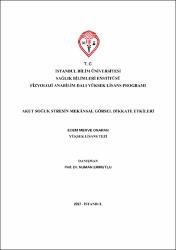| dc.contributor.advisor | Ermutlu, Prof. Dr. Numan | |
| dc.contributor.author | Onaran, Ecem Merve | |
| dc.date.accessioned | 2017-06-30T11:58:38Z | |
| dc.date.available | 2017-06-30T11:58:38Z | |
| dc.date.issued | 2017 | |
| dc.identifier.citation | Onaran E. M. (2017). Akut soğuk stresin mekânsal görsel dikkate etkileri. Yayımlanmamış yüksek lisans tezi. İstanbul: İstanbul Bilim Üniversitesi, Sağlık Bilimleri Enstitüsü | en_US |
| dc.identifier.uri | https://hdl.handle.net/11446/1290 | en_US |
| dc.description | Y. Lisans Tezi | en_US |
| dc.description | İstanbul Bilim Üniversitesi, Sağlık Bilimleri Enstitüsü | en_US |
| dc.description.abstract | Amaç: Bu çalışmada mekânsal görsel dikkatin yönelim bileşeninin endojen dikkat (amaç güdümlü- yukarıdan aşağı denetimli dikkat) ve eksojen dikkat (uyaran güdümlü, aşağıdan yukarı denetimli dikkat) bölümlerinin soğuk ile oluşturulan akut stres altındaki değişimleri araştırılmıştır.
Gereç ve Yöntem: Araştırmaya 40 gönüllü rastgele olarak dört koşul altında, 4°C, 10°C, 25°C suyun içine ayakları sokulmuş olarak ve oda sıcaklığında suya temas etmeden mekânsal görsel dikkat testi olan Posner İpucu Görevini yapmıştır. Bu görevde gönüllülerden görsel hedef ekranda belirdiğinde mümkün olduğunca çabuk klavyeye basmaları istenmektedir. Bazı durumlarda hedeften önce hedefin yönünü önceden doğru olarak işaret eden bir ipucu (endojen yönelim) diğer durumda yanlış yönü gösteren ipucu (uyaran güdümlü yönelim) gösterilir. Çalışmada gönüllülerin dört koşulda kan basıncı, kalp atım hızları ve görsel ağrı skalasında ağrı ölçümleri, mekânsal görsel dikkatin eksojen ve endojen dikkat yönelimlerine karşı reaksiyon zamanları ölçülmüştür.
Sonuçlar: Sonuçlar tekrarlayıcı ölçümler için variyans analizi yapılarak karşılaştırılmıştır. 4°C soğuk suda deneklerin sistolik kan basınçları ve görsel ağrı skalası skorları anlamlı olarak yüksek bulunmuştur. Her koşulda doğru ipuçlu hedeflere karşı reaksiyon zamanları yanlış ipuçlu hedeflere karşı reaksiyon zamanlarına göre anlamlı olarak kısa bulunmuştur. İpucu farkı olmaksızın, 10°C soğuk suda deneklerin reaksiyon zamanları 4°C ve normal şartlara göre anlamlı olarak daha kısa tespit edilmiştir. 4°C koşulda deneklerin yanlış basma oranları (komisyon) diğer koşullara göre anlamlı olarak yüksek bulunmuştur.
4°C soğuk koşulda sistolik kan basıncı ve görsel ağrı skalası skoru artışı akut soğuk stres ortaya çıkarıldığını göstermektedir. Akut soğuk stres, uyaran güdümlü (eksojen) dikkat performansını olumsuz etkilemektedir. 10°C koşulda hedef uyaranlara karşı reaksiyon zamanlarının kısalması, bu sıcaklıkta tetikliğin (alertness) artarak performansı olumlu etkilediğini düşündürmektedir | en_US |
| dc.description.abstract | Objective: This study investigates the changes in endogenous (goal driven – top down controlled attention) and exogenous attention (stimulus driven, bottom up controlled attention) divisions of the orientation component of spatial visual attention under acute stress, induced by cold.
Material and Method: Forty volunteers were subjected to the spatial visual attention test called Posner Cueing Task, where they immersed their feet under random conditions in 4°C, 10°C, 25°C water and without contacting water in room temperature. The volunteers were asked to press the keyboard as quickly as they could, once the visual cue appeared on the screen. In 75% of cases, a valid cue (endogenous orientation) accurately (valid) indicated the direction of the target, while in 25% an invalid cue (stimulus driven orientation) were displayed before the target. In addition, blood pressures, heart rate, the visual pain scale and reaction times of spatial visual attention against exogenous and endogenous attention orientation were measured.
Results: The results were compared with analysis of variance (ANOVA) for repeated measures. The subjects’ systolic blood pressures and scores on visual pain scale in 4°C water were found to be significantly higher. Under all circumstances, the reaction times of those with the valid cues were found to be significantly shorter than the reaction times of those with the invalid cues. Without any cue differences, reaction times of the subjects to targets in 10°C water were found to be significantly shorter than 4°C and normal conditions. The commission rate of subjects was found to be significantly higher in 4°C condition than other conditions.
The increase in the systolic blood pressure and the score on the visual pain scale as in 4°C water reveals acute cold stress. Acute cold stress negatively influences stimulus driven (exogenous) attention performance. The shorter reaction times to targets in 10°C condition suggested increased alertness in this condition and had the effect to enhance performance | en_US |
| dc.language.iso | tur | en_US |
| dc.publisher | İstanbul Bilim Üniversitesi, Sağlık Bilimleri Enstitüsü | en_US |
| dc.rights | info:eu-repo/semantics/openAccess | en_US |
| dc.subject | Dikkat | en_US |
| dc.subject | Soğuk Stres | en_US |
| dc.subject | Uyaran Güdümlü Yönelim | en_US |
| dc.subject | Endojen Yönelim | en_US |
| dc.subject | Eksojen Yönelim | en_US |
| dc.subject | Attention, Cold Stress | en_US |
| dc.subject | Stimulus Driven Orientation | en_US |
| dc.subject | Endogenous Orientation | en_US |
| dc.subject | Exogenous Orientation | en_US |
| dc.title | Akut soğuk stresin mekansal görsel dikkate etkileri. | en_US |
| dc.type | masterThesis | en_US |
| dc.department | DBÜ, Sağlık Bilimleri Enstitüsü, Fizyoloji Ana Bilim Dalı | en_US |
| dc.relation.publicationcategory | Tez | en_US |
| dc.identifier.yoktezid | 494720 | en_US |


















